
ORGANIC ELECTRONICS
Scope & Guideline
Unveiling Breakthroughs in Organic Electronics
Introduction
Aims and Scopes
- Organic Photovoltaics (OPVs):
Research on organic solar cells, including new materials, device architectures, and methods to improve efficiency and stability. This area emphasizes the development of perovskite and non-fullerene solar cells. - Organic Light Emitting Diodes (OLEDs):
Focus on the design, synthesis, and characterization of organic materials for OLED applications. This includes studies on thermally activated delayed fluorescence (TADF) materials and their performance in light emission. - Charge Transport Properties:
Investigations into the charge transport mechanisms in organic semiconductors, exploring factors that affect mobility and efficiency in devices. This includes the study of interface engineering and the effects of morphological changes. - Flexible and Wearable Electronics:
Development of flexible and lightweight organic electronic devices, including sensors and displays, which can be integrated into wearable technology. - Neuromorphic Computing:
Research into the use of organic materials for neuromorphic devices, focusing on their potential applications in artificial intelligence and synaptic transistors. - Electrochromic Devices:
Studies on materials and device architectures for electrochromic applications, emphasizing the integration of organic materials for energy-efficient color-changing technologies.
Trending and Emerging
- Perovskite Solar Cells:
Research on perovskite solar cells is rapidly increasing, with a focus on improving efficiency, stability, and scalability. This includes studies on new materials and interface engineering to enhance performance. - Thermally Activated Delayed Fluorescence (TADF) Materials:
There is a significant trend towards TADF materials for OLED applications, as researchers explore ways to achieve high efficiency and low roll-off in light emission. - Machine Learning Applications:
The incorporation of machine learning techniques in the design and optimization of organic electronic materials and devices is emerging as a popular theme, aiming to accelerate the discovery of new materials. - Biocompatible and Sustainable Materials:
An increasing focus on the development of biocompatible and environmentally friendly materials for organic electronics reflects a broader trend towards sustainability in technology. - Organic-Inorganic Hybrid Systems:
Research on hybrid systems that leverage both organic and inorganic materials to enhance device performance is gaining momentum, particularly in the context of solar cells and photodetectors.
Declining or Waning
- Traditional Organic Photodetectors:
There is a noticeable decrease in research specifically on traditional organic photodetectors as the field moves towards integrating perovskite materials and hybrid systems for improved performance. - Inorganic-Organic Hybrid Devices:
Research on hybrid devices that combine inorganic and organic materials has become less prominent, as advancements in purely organic or perovskite-based devices gain traction. - Basic Characterization Studies:
Studies focused solely on the basic characterization of organic materials without application context are declining, as there is a stronger emphasis on practical applications and device integration. - Low-Performance Device Studies:
Research papers focusing on devices with low efficiency or stability are becoming less common, reflecting a shift towards high-performance materials and devices in published works.
Similar Journals
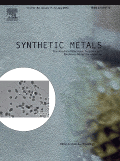
SYNTHETIC METALS
Pioneering Research in Condensed Matter Physics.SYNTHETIC METALS is a leading academic journal published by Elsevier Science SA, focusing on the interdisciplinary field of materials science with an emphasis on the development and application of synthetic metallic materials. Established in 1979, this esteemed journal offers a platform for innovative research that promotes advancements in condensed matter physics, electronic materials, materials chemistry, and mechanical engineering. With an impressive Q1 ranking in Metals and Alloys and Q2 rankings across various other categories, SYNTHETIC METALS serves as a vital resource for researchers, professionals, and students seeking to explore complex material systems and their applications in industry. Although it does not currently offer open access, the journal's impact is highlighted by its robust Scopus rankings, ensuring high visibility and dissemination of meaningful research outcomes. As it progresses through its convergence period to 2024, SYNTHETIC METALS remains dedicated to advancing knowledge and fostering scientific inquiry in the field of materials science.

Semiconductor Physics Quantum Electronics & Optoelectronics
Navigating the Quantum Realm of Electronics and OpticsSemiconductor Physics Quantum Electronics & Optoelectronics, published by the NATL ACAD SCIENCES UKRAINE, INST SEMICONDUCTOR PHYSICS, stands as a significant platform in the fields of semiconductor physics, quantum electronics, and optoelectronics. Since its transition to Open Access in 1998, the journal has facilitated widespread dissemination of innovative research, advancing our understanding of critical applications in technology and materials science. Based in Ukraine, this journal embraces a global readership, supporting researchers and professionals aiming to share valuable findings in a rapidly evolving scientific landscape. With a solid reputation reflected in its category quartiles—including Q4 in Atomic and Molecular Physics, Q3 in Electrical and Electronic Engineering, and Q4 in Electronic, Optical and Magnetic Materials—the journal remains committed to enhancing the visibility and impact of contemporary research. Spanning 2019 to 2024, it invites submissions that contribute to the ongoing dialogue in these pivotal areas, ensuring that new insights reach the academic community swiftly and effectively.

DYES AND PIGMENTS
Pioneering Research in Dyes and Pigments since 1980.Dyes and Pigments, published by Elsevier Science Ltd, stands as a pivotal journal in the field of chemical engineering, particularly focusing on the realms of dyes and pigments as materials with extensive application across industries. Since its inception in 1980, this journal has evolved to capture cutting-edge research until 2024, making significant contributions to both the Chemical Engineering and Process Chemistry and Technology domains, where it currently ranks in the Q2 category. With an impressive Scopus ranking placing it among the top 82nd percentile in General Chemical Engineering and the top 73rd percentile in Process Chemistry and Technology, it demonstrates a robust commitment to publishing high-quality, impactful research. Although it does not offer an open-access option, its comprehensive content remains accessible to a wide audience of researchers, professionals, and students who are deeply engaged in the study and development of new dye and pigment technologies. Engaging with this journal not only enriches knowledge but also facilitates critical discussions that drive future innovations in chemical material sciences.

ACS Applied Electronic Materials
Elevating the Standards of Materials ChemistryACS Applied Electronic Materials, published by the American Chemical Society, is a prominent journal in the field of applied materials science, with a particular focus on electronic, optical, and magnetic materials. Established in 2019, this journal has quickly risen to prominence, achieving a 2023 ranking of Q1 in both Electronic, Optical and Magnetic Materials and Materials Chemistry, as well as Q2 in Electrochemistry, reflective of its high-quality contributions and significant impact within the scholarly community. With an impressive Scopus rank of #22 in Electrochemistry, #59 in Electronic, Optical and Magnetic Materials, and #75 in Materials Chemistry, ACS Applied Electronic Materials serves as an essential resource for researchers, professionals, and students seeking to explore innovative advancements in the field. While the journal is not open access, it offers robust subscription options and aims to foster the dissemination of cutting-edge research articles, reviews, and technical notes that contribute to the understanding and application of electronic materials in various technological contexts. As a platform for pioneering research and cross-disciplinary dialogue, this journal is indispensable for anyone invested in the future of materials science.

ADVANCED FUNCTIONAL MATERIALS
Pioneering Innovations in Functional MaterialsADVANCED FUNCTIONAL MATERIALS is a leading journal published by WILEY-V C H VERLAG GMBH, prominently recognized in the fields of biomaterials, chemistry, condensed matter physics, and materials science. With an impressive impact factor and a distinguished position in the Q1 quartile across multiple categories including nanoscience and nanotechnology, this journal serves as a vital platform for researchers and professionals committed to innovating in functional materials. Since its inception in 2000, ADVANCED FUNCTIONAL MATERIALS has published high-quality peer-reviewed articles that push the boundaries of materials science, exploring new frontiers in electronic, optical, and magnetic materials. The journal's dedication to open access ensures that its groundbreaking findings are readily available to a global audience, fostering collaboration and knowledge-sharing among scholars and practitioners in the field. For those seeking to stay at the forefront of materials research, ADVANCED FUNCTIONAL MATERIALS is an essential resource.
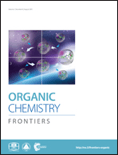
Organic Chemistry Frontiers
Connecting scholars to the latest in organic chemistry.Welcome to Organic Chemistry Frontiers, a premier academic journal published by the Royal Society of Chemistry, dedicated to advancing the field of organic chemistry. With an impressive Q1 ranking in the 2023 category of Organic Chemistry and a notable Scopus rank of 34 out of 211, this journal provides a vital platform for researchers and professionals to disseminate innovative research, cutting-edge methodologies, and comprehensive reviews. Serving as an open-access journal, Organic Chemistry Frontiers aims to enhance the visibility and accessibility of critical research findings in the organic chemistry domain, fostering collaboration and dialogue among scientists worldwide. Since its inception in 2014, it has consistently published high-quality articles that contribute to the progression of knowledge and application in organic chemistry, establishing itself as a cornerstone for students and scholars striving to deepen their understanding and drive forward their research endeavors.
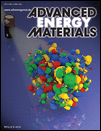
Advanced Energy Materials
Pioneering the Future of Sustainable MaterialsAdvanced Energy Materials is a leading academic journal published by WILEY-V C H VERLAG GMBH, focusing on the rapidly evolving fields of materials science and renewable energy technologies. With an impressive impact factor and recognition as a top-tier journal, it ranks within the Q1 category in both Materials Science (miscellaneous) and Renewable Energy, Sustainability and the Environment as of 2023. Spanning from 2011 to 2024, the journal serves as an essential platform for researchers, professionals, and students eager to explore groundbreaking advancements in energy materials, fostering innovative solutions to global sustainability challenges. The journal's authoritative content is supported by rigorous peer review, ensuring high-quality research contributes to the academic community and beyond. Located in Weinheim, Germany, Advanced Energy Materials stands at the forefront of scientific inquiry, making it an invaluable resource for those invested in the future of energy and materials science.
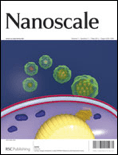
Nanoscale
Connecting Global Minds in Nanoscience.Nanoscale is a premier academic journal published by the Royal Society of Chemistry, dedicated to advancing the field of nanoscience and nanotechnology. With both its ISSN (2040-3364) and E-ISSN (2040-3372) ensuring wide accessibility, the journal is renowned for its high-impact research contributions, reflected in its impressive 2023 Impact Factor and prestigious Q1 ranking in both Materials Science (Miscellaneous) and Nanoscience and Nanotechnology categories. Since its inception in 2009, Nanoscale has fostered a collaborative platform where leading researchers from around the globe share their innovative findings across a multitude of topics spanning from material synthesis to applications in nanotechnology. The journal not only serves as a valuable resource for professionals, researchers, and students but also actively engages the academic community in discussing emerging trends, thus shaping the future of nanoscience. Situated in the heart of the UK at Thomas Graham House, Science Park, Milton Rd, Cambridge CB4 0WF, Nanoscale remains a key publication for those looking to keep abreast of the latest breakthroughs in an ever-evolving field.

SOLID-STATE ELECTRONICS
Illuminating the Path of Solid-State DiscoveriesSOLID-STATE ELECTRONICS, published by Pergamon-Elsevier Science Ltd, is a highly regarded journal committed to advancing the field of solid-state physics and its applications. With an ISSN of 0038-1101 and an E-ISSN of 1879-2405, this journal has been a cornerstone of scholarly communication since its inception in 1960. Covering a rich spectrum of topics, it features in the Q3 category for Condensed Matter Physics, Electrical and Electronic Engineering, and Materials Science, reflecting its robust engagement in these critical fields. Despite not being an open-access journal, it provides valuable insights and research findings accessible to both academia and industry professionals, ensuring the dissemination of cutting-edge knowledge. With a strong focus on empirical research and theoretical developments, SOLID-STATE ELECTRONICS aims to bridge the gap between fundamental science and practical application, making it an essential resource for researchers, professionals, and students alike in the United Kingdom and beyond.
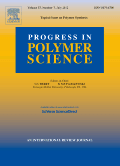
PROGRESS IN POLYMER SCIENCE
Advancing the Frontiers of Polymer ResearchPROGRESS IN POLYMER SCIENCE is a prestigious academic journal published by PERGAMON-ELSEVIER SCIENCE LTD, dedicated to advancing the field of polymer science. With an ISSN of 0079-6700 and an E-ISSN of 1873-1619, this journal has established itself as a leading source of high-quality research since its inception in 1967. It ranks in the top quartile (Q1) across multiple categories including Ceramics and Composites, Materials Chemistry, Organic Chemistry, Polymers and Plastics, and Surfaces and Interfaces, reflecting its strong reputation and impact within the scientific community. The journal features rigorous peer-reviewed articles that not only contribute to theoretical advancements but also emphasize practical applications of polymer science in various industries. Although it is not an open-access journal, it remains accessible through institutional subscriptions and provides invaluable insights and data for researchers, professionals, and students alike. PROGRESS IN POLYMER SCIENCE is essential reading for anyone looking to stay abreast of the latest developments and innovations in this dynamic field.